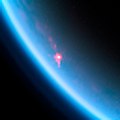File:Sunglint on a Hydrocarbon Lake (PIA18433).jpg

原始文件 (640 × 640像素,文件大小:122 KB,MIME类型:image/jpeg)
摘要
| 描述Sunglint on a Hydrocarbon Lake (PIA18433).jpg |
English: Description from NASA : This near-infrared color image shows a specular reflection, or sunglint, off of a hydrocarbon lake named Kivu Lacus on Saturn's moon Titan. Kivu Lacus is a relatively small lake for Titan -- about 48.2 miles (77.5 km) wide -- located very close to the moon's north pole. The view was obtained during Cassini's flyby on July 24, 2012, also called the "T85" flyby by the Cassini team. This was the most intense specular reflection that Cassini had seen to date. Cassini saw its first specular reflection on Titan on July 7, 2009 (see PIA12481) -- this provided solid confirmation of liquid in the moon's northern hemisphere. Another sunglint was seen on Kraken Mare on August 21, 2014 (see PIA18432). Specular reflections can only be seen when the Cassini spacecraft is in the right place relative to the sun and Titan such that the mirror-like reflection from a lake reflects sunlight directly to the spacecraft. They require the sun to be above the horizon at the location of the lake, which is why none were visible until after Titan's northern spring equinox in 2009 when the seas became illuminated (see PIA17470). The bright, white area represents the glint off of the lake Kivu Lacus. The pink is specular skyglow --- haze illuminated from below by specular reflection off of the lake. The faint pink color coming from just above the specular reflection has been suggested to represent the first waves seen on Titan, and thus the first sea-surface waves ever detected outside of Earth. The view was obtained by the Cassini Visible and Infrared Mapping Spectrometer (VIMS) instrument at a distance of 18,600 miles (30,000 kilometers) from Titan. It is not, however, the same visible-light color that the human eye would see. At visible wavelengths, the human eye would see a hazy orange orb (see PIA14913), and would not be able to see the specular reflection, which would be scattered by Titan's atmospheric haze before reaching space. Red in the image corresponds to a wavelength of 5.0 microns, green corresponds to 2.8 microns, and blue corresponds to 2.0 microns. The crescent of blue sky here results from scattering off Titan's atmospheric haze, which is more intense at shorter (bluer) wavelengths. This image has been interpolated from its original 64-by-64 pixel form. The Cassini-Huygens mission is a cooperative project of NASA, the European Space Agency and the Italian Space Agency. JPL, a division of the California Institute of Technology, Pasadena, manages the mission for NASA's Science Mission Directorate in Washington. The VIMS team is based at the University of Arizona in Tucson. More information about Cassini is available at http://www.nasa.gov/cassini and http://saturn.jpl.nasa.gov. |
||||||
| 日期 | |||||||
| 来源 |
http://www.jpl.nasa.gov/spaceimages/details.php?id=PIA18433
|
||||||
| 作者 | NASA / JPL-Caltech / University of Arizona / University of Idaho | ||||||
| 授权 (二次使用本文件) |
|
许可协议
| Public domainPublic domainfalsefalse |
| 本文件完全由NASA创作,在美国属于公有领域。根据NASA的版权方针,NASA的材料除非另有声明否则不受版权保护。(参见Template:PD-USGov/zh、NASA版权方针页面或JPL图片使用方针。) |  | |
 |
警告:
|
说明
此文件中描述的项目
描繪內容
30 10 2014
文件历史
点击某个日期/时间查看对应时刻的文件。
| 日期/时间 | 缩略图 | 大小 | 用户 | 备注 | |
|---|---|---|---|---|---|
| 当前 | 2018年12月12日 (三) 17:19 |  | 640 × 640(122 KB) | Kesäperuna | 100% JPEG quality from full quality TIFF. |
| 2014年11月4日 (二) 08:41 |  | 640 × 640(17 KB) | Vanished User cdJHGweI3s | User created page with UploadWizard |
文件用途
以下页面使用本文件:
全域文件用途
以下其他wiki使用此文件:
- ar.wikipedia.org上的用途
- en.wikipedia.org上的用途
- fr.wikipedia.org上的用途
- it.wikipedia.org上的用途
- www.wikidata.org上的用途

